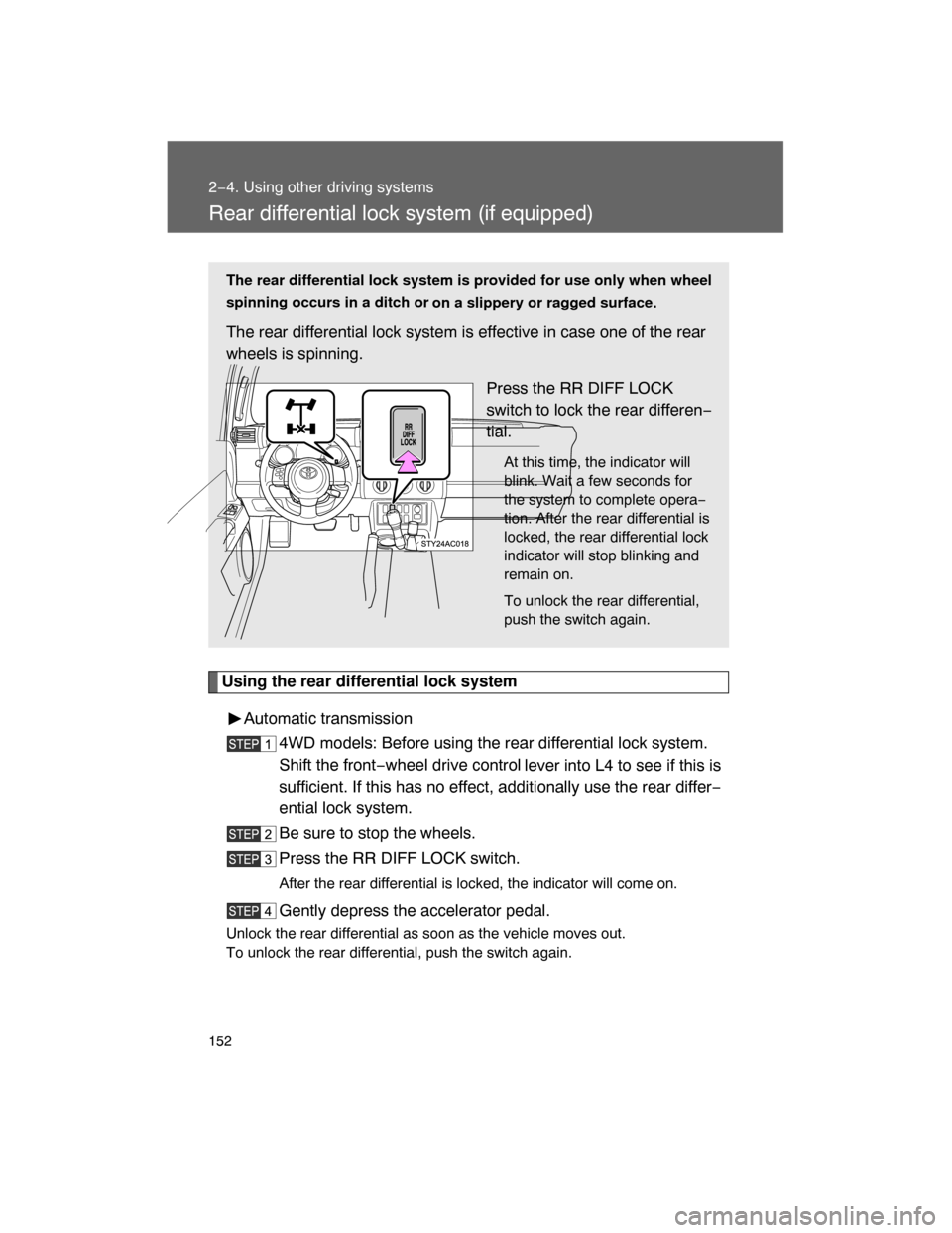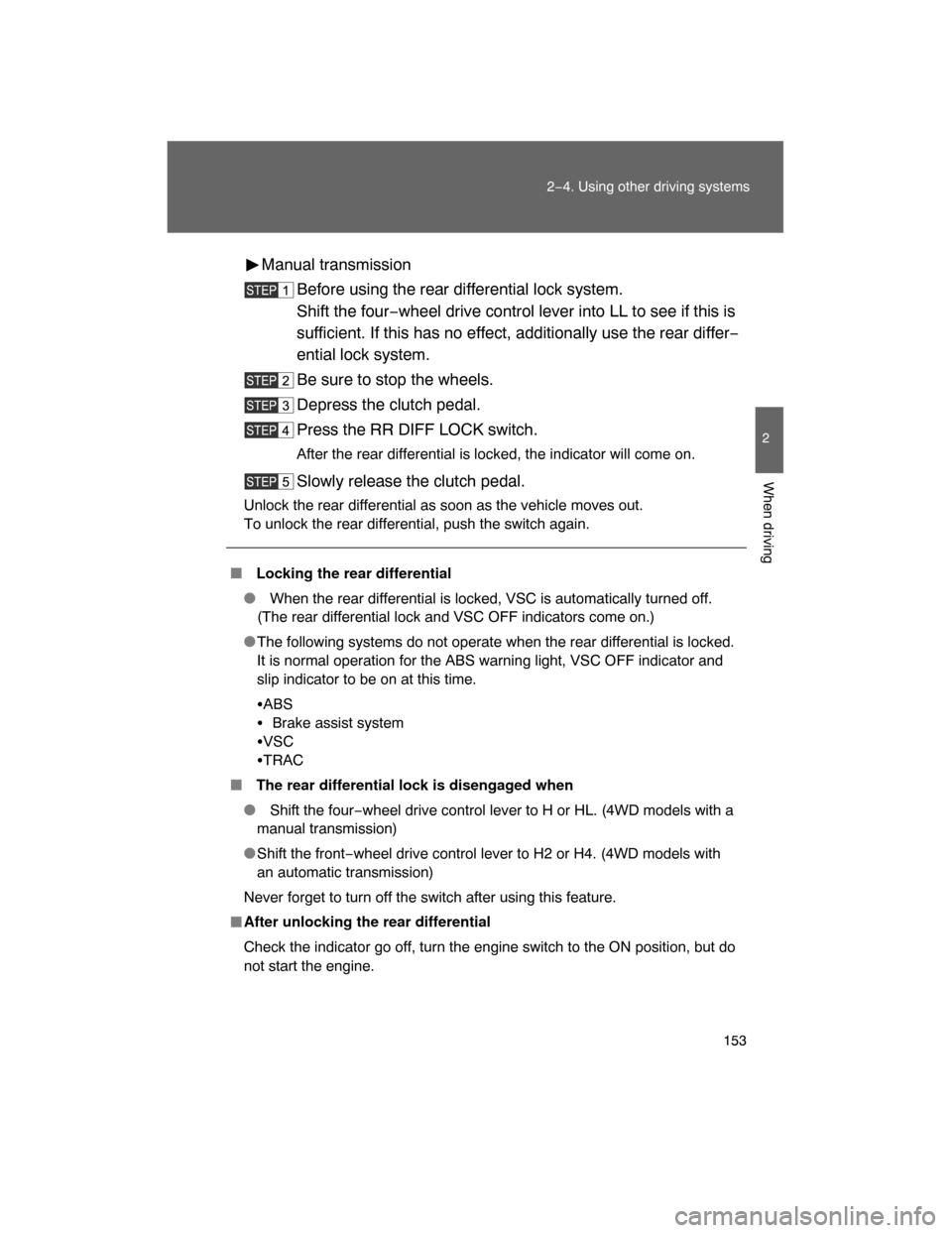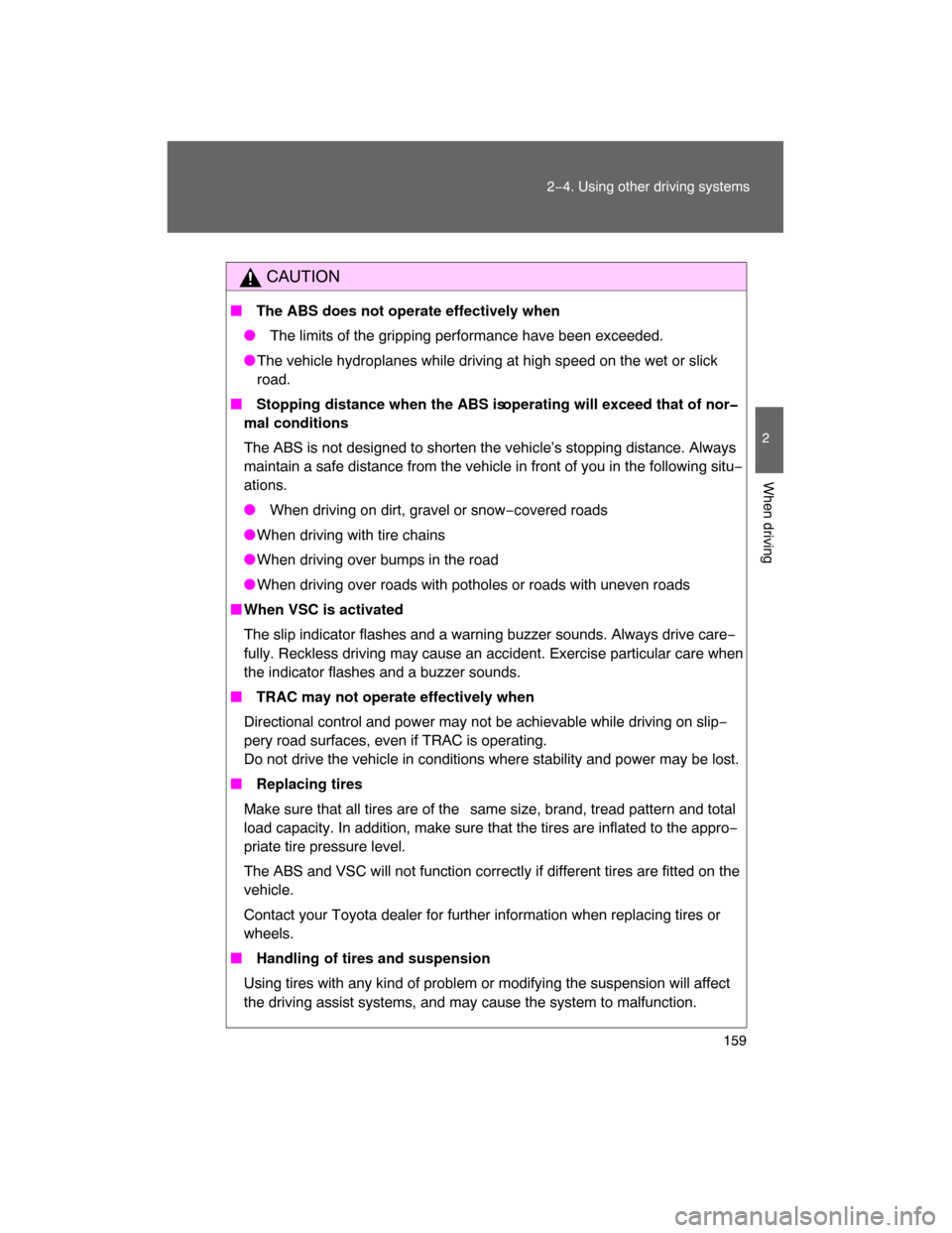Page 146 of 400
148
2−4. Using other driving systems
Active traction control system (if equipped)
When the active traction control system is operating
If all wheels spin, the slip indica−
tor flashes to indicate that the
active traction control system
have been engaged.
The active traction control system automatically helps prevent the
spinning of 4 wheels when the veh icle is started or accelerated on
slippery road surfaces.
� System operation
Vehicles with an automatic transmission:
Shift the front−wheel drive control lever into L4.
Vehicles with a manual transmission:
Shift the four−wheel drive control lever into LL.
Press the A−TRAC switch to
activate the system.
At this time, the active traction
control system indicator will
come on.
To cancel the system, push the
switch again.
Page 148 of 400
150
2−4. Using other driving systems
AUTO LSD system (2WD models)
When the AUTO LSD system is operating
If the rear wheels spin, the slip
indicator flashes to indicate that
the AUTO LSD system have
been controlled the spinning of
the rear wheels.
The AUTO LSD system aids tractio n by using the traction control
system to control engine performance and braking when one of the
rear wheels begins to spin.
The system should be used only wh en wheel spinning occurs in a
ditch or rough surface.
The system is activated when driv ing at a speed under 62 mph (100
km/h).
This system is effective in case one of the rear wheels is spinning.
Press the AUTO LSD switch
to turn on the system.
At this time, the AUTO LSD
indicator will come on.
To turn off the system, push
the switch again.
If the engine is turned off while
the AUTO LSD indicator is on
and then restarted, the indica−
tor will turn off automatically.
Page 150 of 400

152
2−4. Using other driving systems
Rear differential lock system (if equipped)
Using the rear differential lock system
Automatic transmission
4WD models: Before using the rear differential lock system.
Shift the front−wheel drive control
lever into L4 to see if this is
sufficient. If this has no effect, additionally use the rear differ−
ential lock system.
Be sure to stop the wheels.
Press the RR DIFF LOCK switch.
After the rear differential is locked, the indicator will come on.
Gently depress the accelerator pedal.
Unlock the rear differential as soon as the vehicle moves out.
To unlock the rear differential, push the switch again. The rear differential lock system is provided for use only when wheel
spinning occurs in a ditch or
on a slippery or ragged surface.
The rear differential lock system is effective in case one of the rear
wheels is spinning.
Press the RR DIFF LOCK
switch to lock the rear differen−
tial.
At this time, the indicator will
blink. Wait a few seconds for
the system to complete opera−
tion. After the rear differential is
locked, the rear differential lock
indicator will stop blinking and
remain on.
To unlock the rear differential,
push the switch again.
Page 151 of 400

153
2−4. Using other driving systems
2
When driving
Manual transmission
Before using the rear differential lock system.
Shift the four−wheel drive control lever into LL to see if this is
sufficient. If this has no effect, additionally use the rear differ−
ential lock system.
Be sure to stop the wheels.
Depress the clutch pedal.
Press the RR DIFF LOCK switch.
After the rear differential is locked, the indicator will come on.
Slowly release the clutch pedal.
Unlock the rear differential as soon as the vehicle moves out.
To unlock the rear differential, push the switch again.
� Locking the rear differential
� When the rear differential is locked, VSC is automatically turned off.
(The rear differential lock and VSC OFF indicators come on.)
�The following systems do not operate when the rear differential is locked.
It is normal operation for the ABS warning light, VSC OFF indicator and
slip indicator to be on at this time.
�ABS
�Brake assist system
�VSC
�TRAC
� The rear differential lock is disengaged when
� Shift the four−wheel drive control lever to H or HL. (4WD models with a
manual transmission)
�Shift the front−wheel drive control lever to H2 or H4. (4WD models with
an automatic transmission)
Never forget to turn off the switch after using this feature.
�After unlocking the rear differential
Check the indicator go off, turn the engine switch to the ON position, but do
not start the engine.
Page 152 of 400
154 2−4. Using other driving systems
CAUTION
� To avoid an accident
� Do not use the rear differential lock system except when wheel spinning
occurs in a ditch or on a slippery or ragged surface. Large steering effort
and careful cornering control will be required.
� Do not lock the rear differential until the wheels have stopped spinning.
Otherwise, the vehicle may move in an unexpected direction when the dif−
ferential lock is engaged, resulting in an accident. This may also lead to
possible damage to differential lock component parts.
� Do not drive over 5 mph (8 km/h) when the differential is locked.
�
Do not keep driving with the RR DIFF LOCK switch on.
Page 154 of 400

156
2−4. Using other driving systems
Driving assist systems
When VSC/TRAC are operating
If the vehicle is in danger of slip−
ping, or if the rear wheels (2WD
models) or all wheels (4WD
models) spin, the indicator light
flashes to indicate that VSC/
TRAC have been engaged.
A buzzer (intermittent) sounds to
indicate that VSC is operating. To help enhance driving safety a nd performance, the following sys�
tems operate automatically in res
ponse to various driving situations.
Be aware, however, that these systems are supplementary and
should not be relied upon too h
eavily when operating the vehicle.
� ABS (Anti�lock Brake System)
Restrains the vehicle from slipping when driving on slick road surfaces
or in the event of sudden braking.
� Brake Assist
Generates an increased level of braking force after the brake pedal is
depressed, when the system detects a panic stop situation.
� VSC (Vehicle Stability Control)
Helps the driver to control skidding when swerving suddenly or turning
on slippery road surfaces.
� TRAC (Traction Control)
Maintains drive power and prevents the rear wheels (2WD models) or
all wheels (4WD models) from spinning when starting the vehicle or
accelerating on slippery roads.
Page 155 of 400
157
2−4. Using other driving systems
2
When driving
To disable VSC
If the vehicle gets stuck in fresh snow or mud, VSC may reduce
power from the engine to the wheels. You may need to turn the sys−
tem off to enable you to rock the vehicle in order to free it.
Vehicles with rear differential lock system
Press the RR DIFF LOCK
switch.
The rear differential lock and VSC
OFF indicators should come on.
Push the switch again to turn the
system back on.
4WD models with an automatic transmission
Shift the front−wheel drive control
lever to H4 or L4.
The four−wheel drive and VSC
OFF indicators should come on.
Shift the lever to H2, turn the sys−
tem back on.
4WD models with a manual transmission
Shift the four−wheel drive control
lever to HL or LL.
The center differential lock and
VSC OFF indicators should come
on.
Shift the lever to H, turn the sys−
tem back on.
Page 157 of 400

159
2−4. Using other driving systems
2
When driving
CAUTION
� The ABS does not operate effectively when
� The limits of the gripping performance have been exceeded.
�The vehicle hydroplanes while driving at high speed on the wet or slick
road.
� Stopping distance when the ABS is
operating will exceed that of nor�
mal conditions
The ABS is not designed to shorten the vehicle’s stopping distance. Always
maintain a safe distance from the vehicle in front of you in the following situ−
ations.
� When driving on dirt, gravel or snow−covered roads
�When driving with tire chains
�When driving over bumps in the road
�When driving over roads with potholes or roads with uneven roads
�When VSC is activated
The slip indicator flashes and a warning buzzer sounds. Always drive care−
fully. Reckless driving may cause an accident. Exercise particular care when
the indicator flashes and a buzzer sounds.
� TRAC may not operate effectively when
Directional control and power may not be achievable while driving on slip−
pery road surfaces, even if TRAC is operating.
Do not drive the vehicle in conditions where stability and power may be lost.
� Replacing tires
Make sure that all tires are of the same size, brand, tread pattern and total
load capacity. In addition, make sure that the tires are inflated to the appro−
priate tire pressure level.
The ABS and VSC will not function correctly if different tires are fitted on the
vehicle.
Contact your Toyota dealer for further information when replacing tires or
wheels.
� Handling of tires and suspension
Using tires with any kind of problem or modifying the suspension will affect
the driving assist systems, and may cause the system to malfunction.